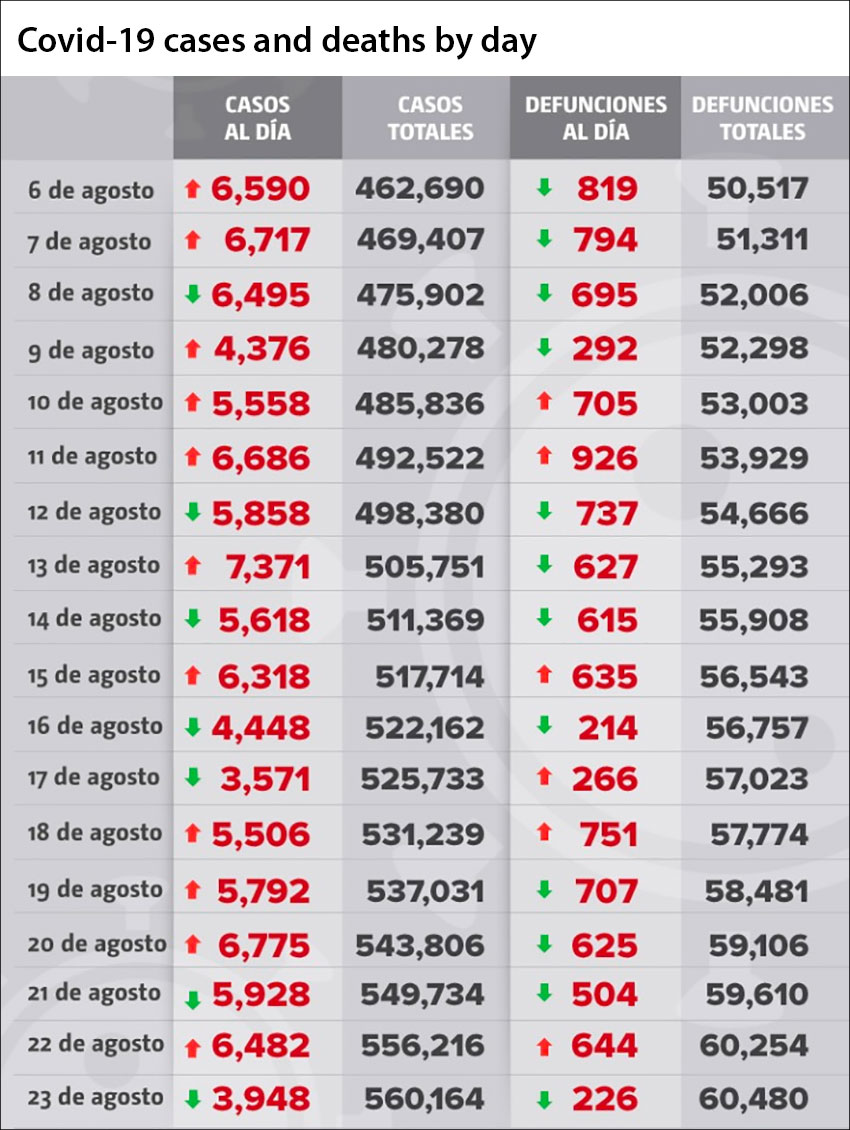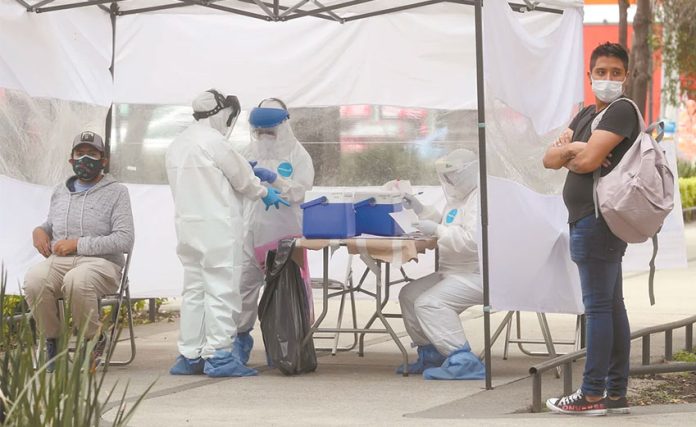New coronavirus case numbers have declined in recent weeks but the situation might not have improved as much as health officials claim: Mexico’s already low Covid-19 testing rate has also recently fallen, meaning that that an even higher number of cases could be going undetected.
Officials including Deputy Health Minister Hugo López-Gatell and Director of Epidemiology José Luis Alomía have asserted in recent days that the pandemic is on the wane in Mexico.
The former, the federal government’s coronavirus czar, said last week that the situation was “very positive” because data from recent weeks show the pandemic is in “a clear phase of descent.”
But data from the University of Oxford shows that the number of Covid-19 tests being performed each day in Mexico has consistently trended downwards in the same period.
On July 21, 0.1 tests per 1,000 people were carried out, according to the Oxford University project Our World in Data, but by August 19 the rate had fallen to 0.07.
Based on those figures, the daily testing rate per 100,000 people fell from 10 to seven in a four-week period but the World Health Organization (WHO) said last week that the rate in Mexico had dropped to as low as three.
By comparison, some 150 tests per 100,000 people are currently being performed every day in the United States, WHO Health Emergencies Program executive director Michael Ryan said Friday.
López-Gatell attributed the drop-off in testing to a decrease in the number of people with coronavirus-like symptoms, rejecting any suggestion that the government is deliberately testing fewer citizens to create a misleading impression that the pandemic is on the wane.
“It is believed that it was decided to reduce the number of tests in order to reduce the number of cases; it’s not true, the [testing] policy is the same. If there are symptoms, a test is done,” he said.
But experts who spoke with the El Universal newspaper agreed that the recent decline in case numbers could be linked to decreased testing.
Malaquías López Cervantes, a public health professor at the National Autonomous University (UNAM) and spokesperson for the university’s Covid-19 commission, was highly critical of the drop-off in testing from an already low rate.

“The worst thing is that in a country where … enough tests have never been done, it’s now being said that we need less [testing],” he said.
The UNAM academic said that it’s regrettable that testing has been mainly targeted at people with severe coronavirus symptoms such as breathing difficulties and therefore people with less serious symptoms have not been tested and included in official data.
Rodolfo de la Torre, director of social development at the Espinosa Yglesias think tank, was also critical of Mexico’s strategy. As a result of the approach, it cannot be certain that new case numbers are in fact going down, he asserted.
“The WHO has established fundamental elements to combat the pandemic, one of them is the number of tests that are carried out. The entire population doesn’t have to be tested but [testing] shouldn’t be limited to serious cases,” de la Torre said.
Widespread testing can play an important role in managing the pandemic because it allows mild and asymptomatic cases to be detected and isolated to stop the spread of the coronavirus, he said. However, “that’s not happening in Mexico,” he added.
Alejandro Macías, a member of UNAM’s coronavirus commission and the federal government’s point man during the swine flu pandemic in 2009, said that more widespread testing would be beneficial because it would provide a clearer picture of how the pandemic is evolving.
Admitting that it sounds “paradoxical,” Macías said that more tests can result in fewer cases in the long term.
“While you’re doing more tests, you’ll have a better chance of finding the sick and being able to isolate them in the immediate term,” he said, adding that community transmission will decrease as a result and the infection rate will fall.
“The ideal would be that contacts [of positive cases] went into isolation and that there was capacity to test them,” Macías said.
However, the reality is that contact tracing has not been carried out widely in Mexico, although some state authorities, such as those in Campeche, have made efforts to do so.
At Sunday night’s coronavirus press briefing, the government’s health promotion chief said that just under 1.26 million Covid-19 tests have been carried out since coronavirus was first detected in Mexico at the end of February.
Confirmed cases rose to 560,164 on Sunday with 3,948 new cases registered. The positivity rate in Mexico is 44.5%, meaning that almost one in two tests performed comes back positive.
The extremely high positivity rate – the rate in the United States is 9%, according to authorities in that country – is widely regarded as a clear indication that Mexico is not testing anywhere near as widely as it should be.
Meanwhile, Mexico’s official Covid-19 death rose to 60,480 on Sunday with 226 additional fatalities reported.
On Saturday, health officials reported 6,482 new cases and 644 deaths.
The lack of testing is widely believed to be hiding not only the real size of the coronavirus outbreak but also the number of deaths caused by Covid-19.
Nevertheless, Mexico has the third highest death toll in the world behind only the United States and Brazil.
According to Johns Hopkins University, Mexico has the fifth highest number of Covid-19 fatalities per 100,000 inhabitants among the countries most affected by the pandemic.
There have been just under 48 deaths per 100,000 residents here as of Sunday, data shows. The countries that currently have higher mortality rates than Mexico are Peru, Chile, Brazil and the United States.
Source: El Universal (sp), El Financiero (sp)
